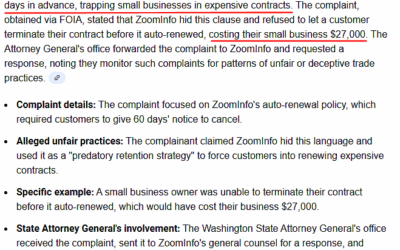B2B Sales Process: 9 Steps to Avoid Failure
Succeeding in B2B sales heavily depends on using data strategically to target the right leads, personalize outreach, and close deals efficiently. If you have the wrong data, outdated data or missing data, the time wasted will be tremendous. Here’s a guide to help you leverage the right data effectively:
1. Identify Your Ideal Customer Profile (ICP)
- Use Firmographic Data: Start by identifying key traits of your best customers, such as industry, company size, revenue, and geographic location.
- Analyze Historical Data: Look at past deals to determine which customer types and segments have had the highest success rates. Use this insight to build a clear profile of your ideal buyer.
2. Implement Intent Data for Timely Targeting
- Identify Buying Signals: Intent data provides insights into which companies are actively researching topics related to your product. Use this data to identify companies likely in-market for your solution.
- Prioritize Leads with Intent: Focus on prospects showing high buying intent, as they are further along in the buying cycle. Intent signals might include frequent visits to your website, engaging with relevant content, or increased activity around keywords related to your industry.
3. Segment Leads for Targeted Outreach
- Use Behavioral and Technographic Data: Understand each prospect’s tech stack, recent purchases, or engagement history. This data can help you segment leads based on needs and readiness.
- Create Tailored Campaigns: Different segments respond to different messaging. For example, a small tech startup may respond to a flexible, growth-focused solution, while a large enterprise may need an emphasis on integration and scalability.
4. Personalize Outreach with Buyer-Specific Insights
- Incorporate Firmographic and Demographic Data: Use information about the company and the specific decision-maker’s role to craft personalized emails or calls. This could include referencing industry trends or specific challenges the prospect is likely facing.
- Leverage Previous Interactions: If a prospect has engaged with past content or visited your site multiple times, reference those actions in your outreach to show relevance and build rapport.
5. Leverage Account-Based Marketing (ABM) Tactics
- Focus on High-Value Accounts: Use data to identify and target high-value accounts that match your ICP. An ABM approach helps you align sales and marketing efforts around specific accounts to drive personalized, high-touch engagement.
- Engage Multiple Stakeholders: Use data to identify key decision-makers and influencers in target accounts, tailoring messages to address their specific needs and roles in the buying process.
6. Optimize Lead Scoring and Qualification with Predictive Analytics
- Automate Lead Scoring: Use predictive analytics to score leads based on historical data, intent signals, and firmographic attributes. Automating this process saves time and prioritizes leads more accurately.
- Qualify Faster: Predictive analytics can help you assess a lead’s likelihood to convert, allowing sales teams to focus on high-probability prospects.
7. Monitor Competitor and Market Trends
- Use Competitive Intelligence: Data on competitors’ activities, such as new product launches or customer reviews, can help you position your product more effectively. It also provides talking points for addressing competitors’ weaknesses.
- Stay Informed on Market Dynamics: Tracking industry trends helps you align your messaging with current customer needs, making your outreach more timely and relevant.
8. Leverage Data for Continuous Improvement
- Analyze Win/Loss Data: Review data on deals won and lost to identify patterns. Look at what’s working and what isn’t to refine your ICP, lead scoring model, and outreach strategies.
- A/B Test Messaging and Channels: Use data from A/B tests to see what messaging, subject lines, and communication channels resonate best with your target audience. This ongoing optimization improves conversion rates.
9. Invest in Data-Driven Tools for Sales Efficiency
- CRM and Sales Intelligence Tools: Ensure you have a CRM integrated with a data platform (like Lead411) to keep data up-to-date and readily accessible for the entire sales team.
- Use Automation for Outreach and Follow-Up: Data-backed tools can automate repetitive tasks, like follow-up emails or reminders, allowing sales reps to focus on high-impact activities.
By using data to inform every stage of the B2B sales process—from targeting the right leads to crafting personalized outreach—you increase efficiency, improve conversion rates, and close deals faster. The key to success is not just gathering data but actively applying it to make strategic, informed decisions.
Recent Posts
Top 5 B2B Data Providers for Energy / CleanTech Companies in 2026 (Reviewed)
Article Summary Energy and clean technology companies need accurate, industry-specific B2B data to identify active projects and decision-makers. The best B2B data providers offer more than contact lists, including intent signals, growth triggers, and verified...
Top 5 B2B Data Providers for Staffing and Recruiting Companies in 2026 (Reviewed)
Summary: For staffing and recruiting firms, having accurate, up-to-date B2B data is essential. Whether you’re targeting HR directors, hiring managers, or C-suite executives, a high-quality data provider can save hours of research and give you a competitive edge. In...
Why Zoominfo Contracts are Hard to Cancel
Quick Summary ZoomInfo contracts often come with long-term commitments and annual billing. Automatic renewals and strict cancellation policies make terminating services tricky. Unused credits and account manager retention efforts can further complicate cancellation....




